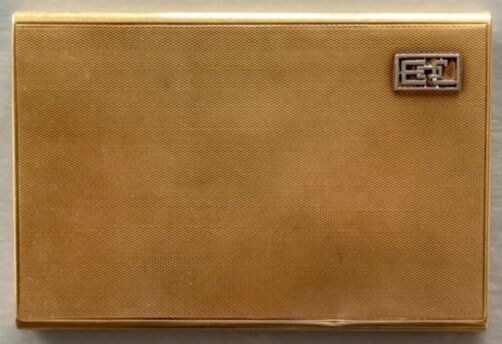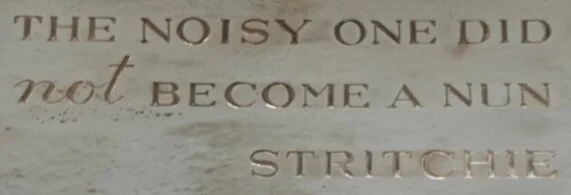Object Of The Month: Elaine Stritch’s Cigarette Case
In a special Object Of The Month double bill, Robert Hazle looks at two cigarette cases which give an insight into a key aspect of Coward’s iconic style.
Apart from dressing gowns and martini glasses, an integral part of Coward’s iconic image must be being seen smoking a cigarette. At the time a chic symbol – the height of ‘cool’. For this Object Of The Month post, which could equally be called ‘The Ones That Got Away’: What You Won’t See At The Art & Style Exhibition, I’ve dug out two cigarette cases from different ends of Coward’s life, each with a story to tell. We’ll come to Elaine Stritch shortly, but first…
1: ‘For Jack from Noël 1926’
Detail, cigarette case (C) NCAT
So says the inscription within this flat, gold case. It’s slightly warn nearly a century on but it is still a striking piece with a decorative art deco ‘feather fan’ pattern on the front and back. At first it’s not easy to open but will a slight slide of the lid to the right, it unlocks to reveal 3 Benson & Hedges cigarettes held down by slightly frayed elastic. There’s a gentle smell of the tobacco. And under the lid, there is an inscription in a stylish script: For Jack from Noël 1926.
‘Jack’ was the nickname of John C. Wilson, the American theatre director and for a time Coward’s lover. They met during the run of The Vortex in 1925 when he came backstage to congratulate him:
“(he) walked nervously, and with slightly overdone truculence into my life.”
Wilson would eventually produce several of Coward’s productions and make his debut as director with Blithe Spirit on Broadway in 1941. The personal relationship was sometimes rocky: Wilson used his position to steal from Coward, who couldn’t help but forgive him. Even once the relationship had become ‘strictly business’, Wilson became jealous of Graham Payn, Coward’s partner from the 1940s onwards, almost scuppering a planned revival of Tonight At 8.30 with Payn in the ‘Coward’ roles.
Cigarette Case, (C) NCAT
In 1937 Wilson married the Russian aristocrat Natalia Pavlovna Paley, a member of the Romanov family. It seems the marriage was really one of convenience and if anything her husband’s homosexuality suited her. Wilson was a very heavy drinker this put a strain on his marriage and friendships. Despite everything, he and Coward remained friends until Wilson’s death in 1961.
1926 was a busy year for Coward. The Rat Trap, The Queen Was In The Parlour, The Marquise, Semi-Monde and Easy Virtue all had their first performances in Britain as producers tried to cash in (not always successfully) on Coward’s new-found celebrity. It was also a year of travel with Wilson, including to Paris, St Moritz, Berlin, New York and West Virginia. Coward’s letters home to his mother refer to him by his private nickname ‘Baybay’.
“I did hate leaving you so dreadfully – and I cried for half an hour with Jack trying to comfort me”
Coward to his mother, writing from the S.S. Olympic, 1926
Together on the trip, they saw a ‘modern jazz version of The Mikado’ in Berlin, a Yale vs Princeton American football game in New York and in December stayed among the mountains of West Virginia:
“Jack and I ride every morning for two hours and it’s perfectly beautiful – the horses are very mild and sweet if a little flatulent”
Coward to his mother, writing from West Virginia, 1926
In the same letter, on meeting Wilson’s family, he wrote:
“I’m going to spend Christmas en famille with the Wilsons. I love Mr Wilson – he’s hard headed and unpretentious and no nonsense. I thought he would be from Jack’s descriptions.”
Perhaps it was for one of these trips that Coward bought Wilson the cigarette case. We may never know, but it is certainly a fascinating insight into not only 1920s style but Coward’s great affection for Wilson.
2. ‘The Noisy One Did not Become A Nun’
Detail, cigarette case, (C) NCAT
The second case is a much larger silver box with two compartments and an inscription: “The Noisy One Did not Become A Nun”, signed “Stritchie” . And as you might have guessed, this was a gift from Elaine Stritch.
The quotation is a reference to the production of Sail Away, which starred Stritch as American divorcee and British cruise ship hostess Mimi Paragon. Originally cast as a relatively minor role, she was clearly the star of the show and prior to the Broadway run, the musical was reworked as a vehicle for Stritch. Listen here to Geoffrey Johnson, Coward’s US Representative, talk about how this came about, and their subsequent friendship:
Cole Lesley Collection, NCAT
“…he really didn’t know Elaine that well, when he cast her, and the reason he cast her was because he saw her in a Broadway show which was not a success, it was called Goldilocks, but he thought this is the girl to play the lead in this … there were two leading ladies, there was one, and actress named Jean Fenn, but she was the straight lady and of course obviously Elaine was the comic relief but he decided in Philadelphia he would cut Jean Fenn’s part out entirely which had never been really done on a Broadway show, and he gave all that material to Elaine, because she kind of played part of it, she was playing a straight role but she also had her comic moments, and they became very, very close because he had to work very close with her to get that combination going and she was very good at it, she could do it, and so they became great buddies...”
extracts from interview with Alison Ramsey of Digital Drama for NCAT
Stritch on her friendship with Coward
In his diaries, Coward confessed that Ms. Stritch sang 'so movingly that I almost cried.' On his decision to make her the show’s star: 'There is no doubt about it. I made the right decision”
Popular songs from the production include "Why Do the Wrong People Travel?" and the title song, "Sail Away”, first used by Coward in his 1950 musical Ace of Clubs.
Not only did Coward write the book, music and lyrics, he also directed the production and designed the show’s poster.
Stritch in Sail Away at the Hippodrome, Bristol, UK, (C) NCAT
SPOTLIGHT ON: Elaine Stritch
Born 1925 in Detroit, Michigan.
Remembered for her distinctive sound and vocal delivery.
Trained: Dramatic Workshop of The New School in NYC, with Marlon Brando and Bea Arthur.
Understudied Ethel Merman for Call Me Madam, later leading the national tour.
4 tony nominations including for the Stephen Sondheim musical Company.
Starred with Donald Sinden in sitcom Two's Company, earning her a BAFTA nomination.
Died aged 89, July 17, 2014.






